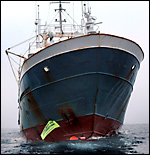
|
Nations involved in Bottom Trawling |
Click to enlarge map
Ocean floor after trawling
|
|
|
|
|
|
What is Bottom Trawling?
|
|
Bottom trawling involves dragging a huge net the size of a soccer field and fitted with heavy metal plates across the ocean floor. It is going on now in our high seas, without limit or law. A handful of countries that allow bottom trawling are wreaking havoc in our oceans that will take centuries for the oceans to recover. Each year they destroy all reef and accompanying marine life in an area twice the size of the USA, systematically wiping out all deep sea life just to catch a few fish. Over 1100 scientists from 69 countries have stated that bottom trawling is a MAJOR environmental threat that must be stopped immediately. UN negotiators are trying to craft a proposal to submit to the General Assembly for a vote in early December.
Bottom-trawling is a method of fishing where huge nets are dragged across the bottom of the deep sea and in the process, everything in their paths are destroyed. This includes coral reefs, sea mounts, and colonies of structure-forming bottom dwellers, such as sponges. In the bottom trawler's wake, the once thriving vibrant coral reefs and other bottom dwelling marine life is replaced by a devasted sea floor that resembles a scraped desert after a bulldozer has passed over it.
Powerful trawlers drag nets across the ocean bottom at depths of up to 1.5 miles. This enables them to reach once inaccessible habitats such as undersea islands known as sea mounts. The nets, with yawning maws up to 200 feet across, are weighted with large steel "doors" that weigh up to 5 tons each. The idea is to "rake" the bottom so that fish there rise into the path of the open net. But the doors, as well as rollers or wheels along the bottom of the net's opening, rip up or crush deep-sea coral reefs, colonies of sponges, and other structure-forming bottom dwellers. For instance, in 1997 during a year's fishing along a formation in the Pacific called the South Tasman Rise, 20 trawlers ripped up an estimated 10,000 tons of coral in the process of harvesting 4,000 tons of their target species, orange roughy, according to conservation groups. Some countries are moving to ban bottom trawling. For example, in March of 2006, the US banned bottom-trawling in waters covering some 150,000 square miles off the US West Coast. Europeans have banned the practice in the Mediterranean at depths greater than 3,200 feet. But outside the 200-mile exclusive economic zones that nations claim, bottom-trawling continues unabated.
An eminent International group of Marine Ecologists demonstrated that the oceans abilities to produce seafood was being reduced due to the loss of biodiversity. Not only are the oceans losing the abilities to produce seafood for humans, they are also losing the ability to resist diseases, and filter pollutants. Bottom trawling is responsible for most of this loss. One third of Ocean species is alleged to have been wiped out by this method. According to the scientists in the study we could run out of seafood in fifty years due to this destructive fishing practice.
We are campaigning for an immediate halt to high seas bottom trawling. If allowed to continue, the bottom trawlers of the high seas will destroy deep sea species, before we have even discovered much of what is down there. Think of it as driving a huge bulldozer through a lush and richly populated forest and being left with a flat, featureless desert. Think of it as beef farming by dragging a net across entire fields, cities and forests to catch a few cows. It's like blowing up Mars before we get there.
Of nearly 84 million tons of fish hauled from the oceans in 2001, bottom-trawling on the high seas accounted for only 0.2 to 0.25 percent of the total, according to a 2004 report by the World Conservation Union, based in Geneva. Members of the European Community account for the biggest share of the high-seas take, with Spain leading the list of worst offenders with 40% of the total. We must all write to our government leaders demanding to outlaw this inefficent and environmentally destructive method of fishing that's causing global devastation daily to the world's oceans by a handful of irresponsible countries and fishing vessels. Perhaps then UN representatives will ratify the proposal to ban bottom trawling when it finally makes it to the General Assembly for a vote.
|
|
|
|
|
Ten reasons why bottom trawling is a stupid idea: |
1. In just a few hours ancient habitat is turned into wasteland, creating giant trawl scars up to four kilometres long.
2. Bottom trawlers target luxury-dining fish such as Orange roughy, or substitutes for depleted white fish stocks, such as Blue Ling and Grenadier.
3. Around 50% of the total catch is thrown overboard dead or dying, including crab, squid, shark, sponge and coral.
4. Hundreds if not thousands of seamounts and ancient coral and sponge systems may have been devastated.
5. 1100 scientists from 69 countries think bottom trawling is a major environmental threat – the 11 bottom trawling countries disagree.
6. Less than 1% of the world’s underwater mountains, “seamounts”, have been scientifically explored.
7. Less than 1% of the fishing industry practices bottom trawling.
8. It takes two tons of fuel to catch one ton of bottom-trawled fish.
9. It destroys ancient deepwater coral systems, which provide food and shelter for fish.
10. Coral and sponge have enormous potential as pharmaceuticals, nutritional supplements, enzymes, pesticides, cosmetics, and other commercial products
|
|
|
|
|
|
|
|
|
|
|
|